Since 2011, Egypt’s political, social and economic circumstances have naturally affected the country’s cultural scene, reshaped people’s expectations as well as reformulated their relation to culture. It is enough to compare 2010, right before the January 2011 Revolution, to the few months of 2014 to notice a tremendous rift between the two scenes.
It is the exceptional dynamism characterising the first months of 2014 that prompted me to look deeper into this phenomenon. Compared to what was normal for any given year prior to the revolution, today affords a new reality we cannot overlook, one of whose clearest signs is the nature, character, aims and purpose of cultural festivals.
The main factor that triggered my interest in cultural festivals was the sheer fact of their abundance in the past few months. Beginning with January until the present, the country has witnessed a long sequence of such artistic events spanning the performing and visual arts, music, dance, theatre, film and artistic discussions and seminars. A representative selection would include the Luxor Egyptian and European Film Festival (19-25 January), the Aswan International Festival for Arts and Culture (18-23 February), the Cairo International Jazz Festival (13-16 March), the Hakawy International Arts Festival (16-23 March), the Downtown Contemporary Arts Festival (D-CAF, 20 March-11 April), the Damanhour International Folk Festival (30 March–3 April), India by the Nile (1-20 April), the International Festival for Drums and Traditional Arts (19-25 April) and the Spring Festival (24 April-26 May).
Quantity is not enough to generate the noteworthy trend, and it is in the quality department that we find ourselves raising our eyebrows and thinking about the many changes that took place over the past few years. Not only have many transformations of post-2011 Egypt led to disappearance of the few older festivals from the ministry’s agenda, but the changes have also introduced new initiatives motored by both state and independent players.
This is not to forget the independent festivals that were already known on the scene, whose presence the events of 2011 have only strengthened, pushing the organisers to invest even more energy in perfecting their organisation. By stepping into the equation, the independent scene managed to contribute to Egypt’s artistic development, but it also started reshaping our understanding of the role and mission of any given cultural event. As such 2011 becomes a threshold on Egypt’s cultural course.

5 Apr: Street Dance Performances / Egypt, The Netherlands (Photo: Bassam Al-Zoghby)
A Threshold Year and Beyond
In August 2011, while moving across the stages erected at the Saladin Citadel hosting Cairo’s annual Summer Festival, an event organised by the Cairo Opera House — a division of Ministry of Culture — I was wondering about the future of such initiatives, pondering several state-run festivals that were to be promptly swept away with January 2011 revolution.
Those musings generated an article entitled "Egypt's summer craves ambitious musical projects." In it, I grieved over the decisions of the then Minister of Culture Emad Abou-Ghazi to cancel a number of festivals that had been held regularly for two, sometimes three decades.
Among the victims were the 23rd edition of the Cairo International Festival for Experimental Theatre, and the 35th edition of the Cairo International Film Festival, which nevertheless returned in 2012 — only to disappear again in 2013. Soon afterwards, we discovered that the cultural map also lost the Cairo International Film Festival for Children. For decades, those state-run festivals were the embodiment of Egypt’s frozen-in-time culture, a testimony to the old regime’s strength in numbers: large festivals, hundreds of invitees, dozens of performances or films, financial profusion – all paralleled by the startling need for thematic definitions as well as organisational and contextual reassessments.
A very truthful description of the procedures dictating one of the pre-2011 ministerial initiatives – the Cairo International Festival for Experimental Theatre (CIFET), held by the ministry since the late 1980s, and cancelled in 2011 – is captured by Dragan Klaic in his book Resetting the Stage: Public Theatre Between the Market and Democracy (2012). Klaic points out that “the foreign embassies [were] asked [by the Ministry of Culture] to send a production of their choice, with modest hospitality offered by the host but no fee. Consequently, the programme [was] a hodgepodge of arbitrary and incidental choices, often made by diplomats and ministry bureaucrats back in Europe, without any sense of the Cairo context and the predilections of its audience.”
Naturally when, in 2011, Abu Ghazi cancelled CIFET and other state-run events, he explained the decision by pointing to political instability. The excuse was only partially satisfactory since one could not stop comparing the situation with that of another Arab Spring country, Tunisia, where festivals were not discontinued. Informed parties understood that the financial crisis was behind cancellation or postponement of several of the ministry’s lavish activities.
The financial obstacle could have been predicted. In 2011, the ministry received a great blow when it was divorced from the funds-generating Supreme Council of Antiquities, which by turning into an independent Ministry of State for Antiquities, took its wealth along with it. The survival of over 60 thousand employees on the ministerial payroll, the running costs of many cultural sectors and the accumulation of administrative negligence made it hard for the ministry to keep its head above water.
The Aswan International Festival for Arts and Culture, the Damanhour International Folk Festival and the International Festival for Drums and Traditional Arts are among the younger, post-2011 breed of ministry-run festivals. While their names point to the ministry’s interest in promoting Egyptian, regional and international artistic heritage, bringing its fruit to Cairo and other major cities, there is not enough data to suggest any modification in approach on the level of innovation, planning, evaluation or execution.
While financial limitations became a new factor to top all other challenges, there is one element that the ministry never had to worry about: its stages. The ministry can freely use dozens if not hundreds of locations that it runs, a luxury that no independent institution has at its disposal.
On a marginal note, it is worth adding that many of the ministry-run festivals had a competitive character, a procedure characterising many major regional and international festivals. This strategy was in large part dropped by the post-2011 initiatives and, in the case of the independent scene, the competitive element was effaced in most cases, testifying to the artistic satisfaction being drawn from the creative process of the whole event.
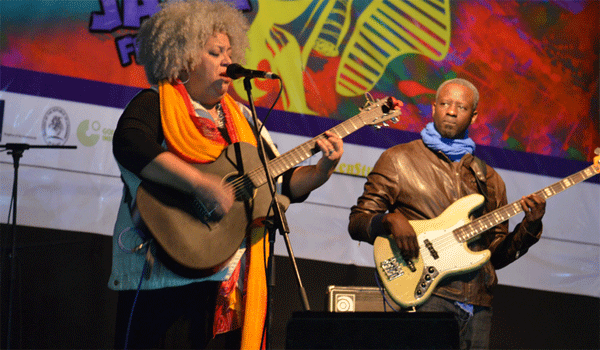
KJ Denhert performs during the 2013 Cairo International Jazz Festival (Photo: Dan Tookey)
Today it is easier for us, as we grasp the creative progression, to notice that 2011 was already marked by a number of budding players who were only strengthening their projects. The third edition of the Cairo Jazz Festival was still confined to the walls of El-Sawy Culturewheel, which it left in the following years, finding a successful new home on the stages of Al Azhar Park.
Along parallel lines, among the established gems present at that time were cultural feasts organised by the Culture Resource (Al Mawred Al Thaqafy) such as the biannual Spring Festival running since 2004, Hayy, Ramadan’s annual festival, and their latest initiative CirCairo which saw its first edition in 2010. The Cairo Video Festival, organised by Medrar since 2005 and bringing video art and experimental films by Egyptian and international artists and filmmakers to the Cairo audiences, was particularly enriched by new material provided by the socio-political transformations.
The Panorama of European Film organised by the Misr International Film production company was already established; and since its third edition in 2010, it only became stronger at the level of organisation. While resuming and improving its unique line-up year by year, on the theatrical, marketing and logistical levels, the Panorama successfully challenged the broad selection and fragile organisation of the Cairo International Film Festival.
In terms of newcomers, 2011 and the following years witnessed the birth of numerous new initiatives.
October 2011 marked the first edition of the Hakawy International Arts festival for Children, a captivating theatre-filled initiative. In 2012 the first edition of the Downtown Contemporary Arts Festival (D-CAF) suffused city centre with international, multi-disciplinary contemporary arts, showing equal dynamism in the following years. In 2013, India by the Nile, a festival of performing and visual arts, entered the scene with a bang, bringing Indian art and culture to Egypt and forging many valuable links between the cultures of both countries.
Equally the past 3 years witnessed the emergence of many other festivals that are smaller in size but no less ambitious, some of which did not manage to survive for a variety of different reasons. The promising International Cairo Jazz Mania, organised by the Yehya Khalil Foundation for the Culture of Jazz Music, was coming into sight before Khalil dropped it to embark instead on a series of self-managed jazz concerts, “The Revolution Is On”, which he has continued to date.
Cairo’s Hal Badeel (Alternative Solution) Festival for Arts, held in April 2013, depended in large part on voluntary work with practically no budget and as such found it difficult to sustain itself. Yet the abundance of festivals, especially those of the independent sector, has been overwhelming.
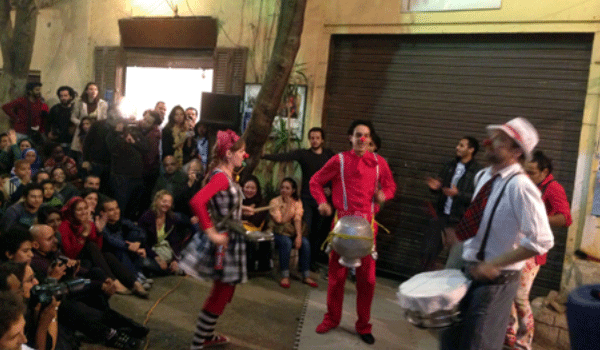
Outa Hamra Troupe performs during Hal Badeel festival, 2013. Photo: Rowan El Shimi)
It's No Magic
Resulting directly from the social, political and economic transformations that took place in the threshold year, those independent players set a number of their own rules on how to motor such cultural activities, keeping in mind such — crucial — factors as clearly defined thematic content, target audience, development plans, network analysis, sustainability strategies and recognition of specific social and cultural constraints, along with public relations, marketing, branding etc..
It is through discussions and interviews with the festivals’ key players that one finds out about the weight that such institutions attach to every detail. Among the main success factors of the independent players’ activities is their recognition of the loopholes found in the cultural map.
As such, today, the Hakawy Festival run by AFCA for Arts and Culture is the sole large-scale theatre arts event dedicated to children, and the only alternative to the ministry-run Cairo International Film Festival for Children, which is no longer taking place. While performances take place in Cairo, Mohamed El-Ghawy, the AFCA director, takes a step further by reaching out to children from small towns and underprivileged neighbourhoods, bringing them over to attend the festival’s performances. In its turn, the Culture Resource’s CirCairo provides a unique opportunity to witness circus performances from all around the world.
“Festivals always have a theme,” writes Donald Getz, professor Emeritus at the University of Calgary in Canada, in paper entitled “The Nature and Scope of Festival Studies” (published in the International Journal of Event Management Research in 2010), “and they have potentially very diverse programs and styles, all in pursuit of fostering a specific kind of experience. Celebration embodies at once an intellectual, behavioural and emotional experience. The core phenomenon of event studies is the event experience and meanings attached to it. Festivals are celebrations, so by definition they have a theme. They also have a variety of meanings, from different perspectives, that make them complex planned phenomena. Event designers are particularly interested in knowing how their manipulation of setting, program and various human interactions affects the audience and/or participants, and whether or not the desired experiences and consequences are achieved. This requires knowledge of culture, the arts, and environmental psychology.”
Getz’s statements can only be complemented by the words of Sanjoy Roy, director of Teamwork Arts, in an interview conducted with him on those pages a few weeks back. Roy’s company brings a plethora of Indian cultural riches to audiences worldwide and also organises the Egypt-based India by the Nile. In the interview, he pointed to the fact that organising the festival is not only about bringing a group of artists and performances to one location; it’s about making the experience unique and worthwhile. “It’s about this particular experience, colours, people, crowd, intellectual discourse – all this makes the whole journey unique,” he said. India by the Nile is one of the examples of the fascinating marriage between a presentation of India’s culture and a dynamic interaction between it and the artists and literary figures of the host country.
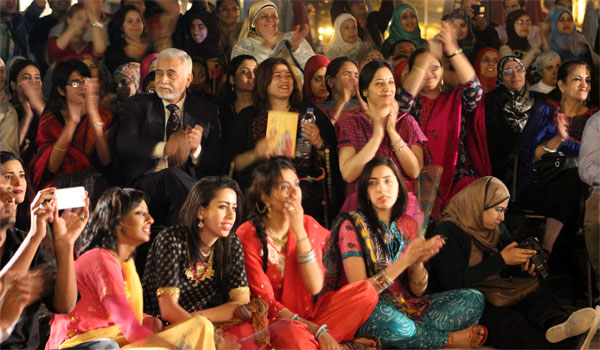
Audience representing all generations and coming from all walks of life attends India by the Nile festival (Photo: Ati Metwaly)
One can argue that players such as Teamwork Arts and Culture Resource have a strong portfolio of large-scale event organisation experience, the first one with over three decades of international activities, the latter with one decade of unprecedented regional dynamism which extends to many layers of culture. On the other hand, other seniors in the field, such as Misr International Films (MIF), keep probing the scene. MIF expands scope of Panorama of the European Film with each round, adding a growing number of educational elements. The company has recently launched its new venture, Zawya, an alternative cinema project. Following in the footsteps of the seniors, the younger independent players are learning the craft with unprecedented speed. Clearly, it is not only about years of experience, but also about passion and determination to make a difference.
“A good recipe for a successful festival is a long-term vision, proper organisation and willingness to constantly innovate,” comments Youssef Shazli from Misr International Films. His strategy is reflected in the words of Mohamed El-Ghawy from AFCA, who points to three factors: “programming that should be based on good research, community involvement through awareness of the target audience, documentation which helps assess and formulate further plans,” El-Ghawy was telling me in our Skype conversation, since he is busy touring Europe, researching content for the further editions of Hakawy, a regular procedure for a festival manager.
Listening to such independent cultural players, one is struck by their dedication but what raises one’s eyebrows is realising that such ambitious scenarios are actually acted out by a handful of people.
Basma El-Husseiny, the founder and director of Al Mawred Al Thakawy, reveals that her entire team consists of 30 people with around 10 involved in pulling each festival together. The Hakawy Festival relies on the dynamic cooperation of a team of similar size: two full timers (including El-Ghawy), four part-timers and five volunteers. Those two examples testify to the fact that efficiency can be generated from a small, yet professional and dynamic team.
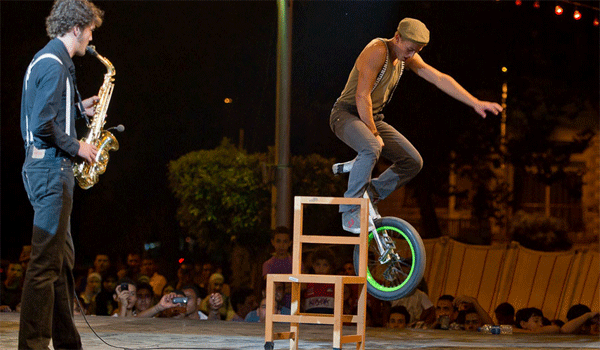
International Circus Festival (CirCairo) launches its Cairo festivities with a public event in Abdeen Square in front of Abdeen Palace, 2012. (Photo: Bassam Al Zoghby)
Quite a shocking realisation when we recall the employees of the ministry who number in the thousands. A huge number of staff, hundreds of venues and complicated logistics demand an extremely high budget, even today.
According to data provided by the Ministry of Finance, the budget of each department reaches several and at times dozens of millions. It is enough for an idea of the size of the ministry to realise that the Cultural Palaces Authority — only one department — includes 559 cultural palaces and houses (according to the Central Agency for Public Mobilisation and Statistics in 2012 ), with many in a deplorable condition and non-functional. One can also imagine how huge the budget needed to revamp those locations must be, but also how they remain inadequate venues for artistic activities.
With so many challenges and decades of accumulated administrational debris, it is clear that the Ministry of Culture is in a particularly difficult position. The gap that has widened between the ministry and independent cultural players will take time and effort to disappear, if it does at all.
Over the past three years, the Ministry of Culture had no choice but to support the independent scene by providing some facilities, such as theatre stages, or offering occasional support in hotel accommodation. Though a few independent organisations point to the procedural obstacles that this cooperation includes, one should be glad that it exists against all odds.
On the other hand the foreign institutions operating in Egypt, such as the British Council, the Goethe-Institute in Cairo, the French Institute and the Dutch, Norwegian, Danish institutions, along with the European Union Delegation, have become increasingly involved in either supporting independent initiatives or motoring their own exchange projects.
Taking all the above into account, another shock results from the realisation that independent festival organisers need relatively modest budgets to realise their extremely valuable initiatives. Budgets amount to approximately USD 150-250 thousand for events like the Spring Festival, the Hakawy and the Panorama, with much lower figures for the Hayy and CirCairo festivals, and a large percentage of that is provided in the form of services and direct investments that donors provide in order to bring an artist or a troupe to Egypt, or support a specific technical or logistical task.
The operational budget of the Ministry of Culture poured to the festivals’ organisation, on the other hand, is not known as the ministry does not reveal such details. What we do know is that very round figures are provided by the Ministry of Finance, with departments of the culture ministry costing between USD 2 million and a few dozens of millions. Of course, due to lack of precision and the thousands of employees on the ministerial payroll, it is neither possible nor fair to formulate any mathematical comparisons between state-run and independent festivals.
We also realise that it is not about numbers, but rather the efficiency that comes along with them. An important factor remains the contribution made by such events to the economy, with the independent sector not falling far behind — a far more promising picture than the one I pictured in 2011.
It is a natural need for the independent players to challenge governmental art practices. This phenomenon always results from the need to formulate ideas that are not mainstream and as such suggest something distinctive. What is happening in Egypt is that the independent festival movement that we are witnessing began shaping public perception of culture, suggesting valid and well studied formulas in the field of cultural management.
Taking into account the history of the ministry, a closer collaboration between it and the independent scene could probably generate fascinating artistic propositions. But is this solution feasible or acceptable by any of the parties involved? The decades-long rift between the two and persistence of obstacles might be too fundamental an obstacle.
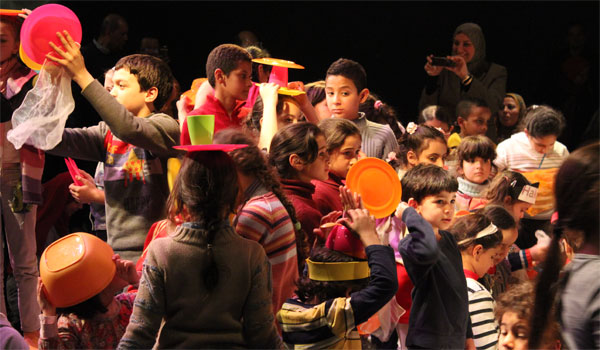
Children join fun activities organised after one of the performances at the Hakawy International Arts Festival, March 2014 (Photo: Ati Metwaly)
Short link: